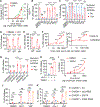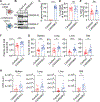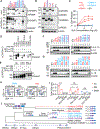The CARD8 inflammasome dictates HIV/SIV pathogenesis and disease progression
- PMID: 38428396
- PMCID: PMC10919936
- DOI: 10.1016/j.cell.2024.01.048
The CARD8 inflammasome dictates HIV/SIV pathogenesis and disease progression
Abstract
While CD4+ T cell depletion is key to disease progression in people living with HIV and SIV-infected macaques, the mechanisms underlying this depletion remain incompletely understood, with most cell death involving uninfected cells. In contrast, SIV infection of "natural" hosts such as sooty mangabeys does not cause CD4+ depletion and AIDS despite high-level viremia. Here, we report that the CARD8 inflammasome is activated immediately after HIV entry by the viral protease encapsulated in incoming virions. Sensing of HIV protease activity by CARD8 leads to rapid pyroptosis of quiescent cells without productive infection, while T cell activation abolishes CARD8 function and increases permissiveness to infection. In humanized mice reconstituted with CARD8-deficient cells, CD4+ depletion is delayed despite high viremia. Finally, we discovered loss-of-function mutations in CARD8 from "natural hosts," which may explain the peculiarly non-pathogenic nature of these infections. Our study suggests that CARD8 drives CD4+ T cell depletion during pathogenic HIV/SIV infections.
Keywords: CARD8; CD4(+) T cells; HIV; SIV; caspase 1; inflammasome; non-human primates; pyroptosis; viral entry; viral protease.
Copyright © 2024 The Author(s). Published by Elsevier Inc. All rights reserved.
Conflict of interest statement
Declaration of interests The authors declare no competing interests.
Figures







Similar articles
-
CARD8: A Novel Inflammasome Sensor with Well-Known Anti-Inflammatory and Anti-Apoptotic Activity.Cells. 2024 Jun 13;13(12):1032. doi: 10.3390/cells13121032. Cells. 2024. PMID: 38920661 Free PMC article. Review.
-
Increased stability and limited proliferation of CD4+ central memory T cells differentiate nonprogressive simian immunodeficiency virus (SIV) infection of sooty mangabeys from progressive SIV infection of rhesus macaques.J Virol. 2014 Apr;88(8):4533-42. doi: 10.1128/JVI.03515-13. Epub 2014 Feb 5. J Virol. 2014. PMID: 24501416 Free PMC article.
-
Dualtropic CXCR6/CCR5 Simian Immunodeficiency Virus (SIV) Infection of Sooty Mangabey Primary Lymphocytes: Distinct Coreceptor Use in Natural versus Pathogenic Hosts of SIV.J Virol. 2015 Sep;89(18):9252-61. doi: 10.1128/JVI.01236-15. Epub 2015 Jun 24. J Virol. 2015. PMID: 26109719 Free PMC article.
-
CARD8 is an inflammasome sensor for HIV-1 protease activity.Science. 2021 Mar 19;371(6535):eabe1707. doi: 10.1126/science.abe1707. Epub 2021 Feb 4. Science. 2021. PMID: 33542150 Free PMC article.
-
Walk on the wild side: SIV infection in African non-human primate hosts-from the field to the laboratory.Front Immunol. 2023 Jan 12;13:1060985. doi: 10.3389/fimmu.2022.1060985. eCollection 2022. Front Immunol. 2023. PMID: 36713371 Free PMC article. Review.
Cited by
-
Targeting inflammasomes as a therapeutic potential for HIV/AIDS.Cell Mol Life Sci. 2025 Apr 17;82(1):162. doi: 10.1007/s00018-025-05685-x. Cell Mol Life Sci. 2025. PMID: 40244456 Free PMC article. Review.
-
Help or Hinder: Protein Host Factors That Impact HIV-1 Replication.Viruses. 2024 Aug 10;16(8):1281. doi: 10.3390/v16081281. Viruses. 2024. PMID: 39205255 Free PMC article. Review.
-
CARD8: A Novel Inflammasome Sensor with Well-Known Anti-Inflammatory and Anti-Apoptotic Activity.Cells. 2024 Jun 13;13(12):1032. doi: 10.3390/cells13121032. Cells. 2024. PMID: 38920661 Free PMC article. Review.
-
HIV, Inflammation, and Immunometabolism: A Model of the Inflammatory Theory of Disease.Viruses. 2025 Jun 11;17(6):839. doi: 10.3390/v17060839. Viruses. 2025. PMID: 40573430 Free PMC article. Review.
-
The multifunctional regulatory post-proline protease dipeptidyl peptidase 9 and its inhibitors: new opportunities for therapeutics.Cell Mol Life Sci. 2025 Apr 28;82(1):187. doi: 10.1007/s00018-025-05719-4. Cell Mol Life Sci. 2025. PMID: 40293537 Free PMC article. Review.
References
-
- Psallidopoulos MC, Schnittman SM, Thompson LM 3rd, Baseler M, Fauci AS, Lane HC, and Salzman NP (1989). Integrated proviral human immunodeficiency virus type 1 is present in CD4+ peripheral blood lymphocytes in healthy seropositive individuals. J Virol 63, 4626–4631. 10.1128/JVI.63.11.4626-4631.1989. - DOI - PMC - PubMed
-
- Schnittman SM, Greenhouse JJ, Psallidopoulos MC, Baseler M, Salzman NP, Fauci AS, and Lane HC (1990). Increasing viral burden in CD4+ T cells from patients with human immunodeficiency virus (HIV) infection reflects rapidly progressive immunosuppression and clinical disease. Ann Intern Med 113, 438–443. 10.7326/0003-4819-113-6-438. - DOI - PubMed
MeSH terms
Substances
Grants and funding
LinkOut - more resources
Full Text Sources
Medical
Molecular Biology Databases
Research Materials

